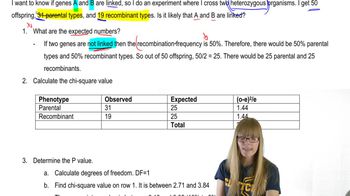Textbook Question
In a type of parakeet known as a 'budgie,' feather color is controlled by two genes. A yellow pigment is synthesized under the control of a dominant allele Y. Budgies that are homozygous for the recessive y allele do not synthesize yellow pigment. At an independently assorting gene, the dominant allele B directs synthesis of a blue pigment. Recessive homozygotes with the bb genotype do not produce blue pigment. Budgies that produce both yellow and blue pigments have green feathers; those that produce only yellow pigment or only blue pigment have yellow or blue feathers, respectively; and budgies that produce neither pigment are white (albino).
A cross is made between a pure-breeding green budgie and a pure-breeding albino budgie. What are the genotypes of the parent birds?
236
views




